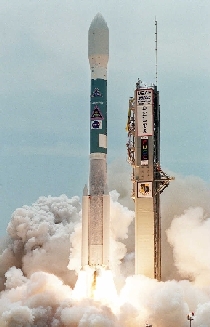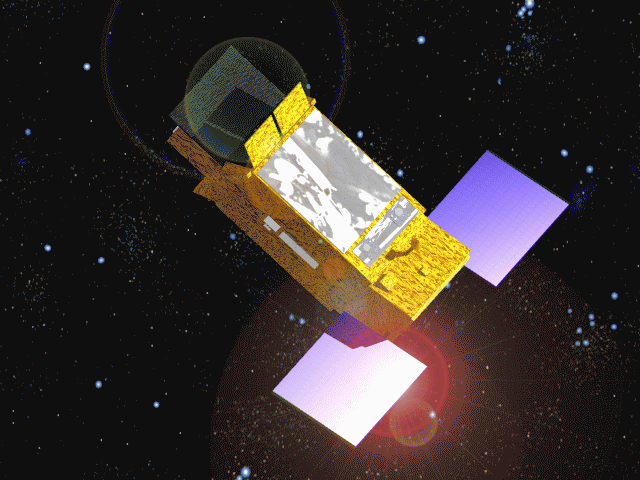

Mission Status Report #47 Star Date: June 13, 2001
FUSE--Two Years On Orbit!!Caption: (Left) FUSE Launch, June 24, 1999. (Right) Artist's concept of FUSE on orbit. (Graphic provided by the Canadian Space Agency. See
Hello World, All continues to go well on the FUSE project as the satellite approaches the two year anniversary of launch, June 24, 1999. (Want to reminisce? Go to the FUSE Launch Archive page [link no longer active - for pictures see The FUSE gallery for a large selection of launch related photos].) We are just over half way through the primary science mission, even as we have been planning for an expected period of extended operations beyond November 2002. FUSE completed its 10,000th revolution of the earth on May 17, 2001, and has observed over 1500 celestial objects. There has been one significant event since my last report, and that was the failure of one gyro in Inertial Reference Unit-A on May 30th. The good news is that we were back on the science timeline and operating again in less than 24 hours, which is just an outstanding turnaround for a problem such as this! FUSE has two redundant IRU packages, each of which contains three gyroscopes that aid in attitude control (one for each of three independent axes of motion). When one gyro in IRU-A failed, the spacecraft switched automatically to IRU-B, but stayed in a safe pointing mode until ground controllers assessed the situation. Once it was clear what had happened, the ground ops team resumed normal operations using IRU-B. We restricted maneuver lengths for about one week until we could fully calibrate IRU-B, but we are now back to normal operating mode. So what is the impact of this on downstream operations? None initially. We operated for 23 months with IRU-A, which had many more hours of ground operations time than IRU-B has had. There is no reason to expect any near term problems. However, we have lost one aspect of redundancy in the system that it would be nice to have. If we were to lose a gyro in IRU-B, we could operate in a so-called "cross-strapped" mode using one or more gyros from both IRU packages (so long as it is not the gyro that controls the same axis as the one lost in IRU-A). This would be the first fallback position. We have further redundancy even beyond that, and it may be possible to operate even with NO gyros, using just the FES guidance camera and the magnetometers. However, to operate in such a mode will require significant development of new control software, which of course takes time (and costs money!). In any event, we are assessing the downstream options and plan to have protocols in place to handle any eventualities. On another front, the ground-swell of science results from FUSE continues. The last month has seen a significant increase in the number of scientific papers submitted to the professional literature on FUSE results. In addition, there were at least 23 presentations made at the summer American Astronomical Society meeting that just concluded in Pasadena CA, and many other results are being presented over the summer at professional meetings around the world! It is indeed gratifying for the JHU Operations team to see these results coming out, especially knowing that it is the tip of the iceberg and the best is yet to come! The input phase for Cycle 3 observations concluded on May 11, 2001. A total of 178 proposals for new observations were submitted to NASA, requesting between 2.5 and 3 times the amount of time available! This strong showing indicates that the astronomical community at large is becoming knowledgeable about FUSE and its capabilities, and is becoming aggressive about pursuing observing time Over the next several months, NASA will go through the process of assessing these proposals and choose a set of Guest Investigator observations for the observing year beginning this December. Thanks to all who proposed, and good luck! (See the FUSE Guest Investigator page [no longer in existence] for further information.)
Reported by: Bill Blair, Chief of Observatory Operations
|

